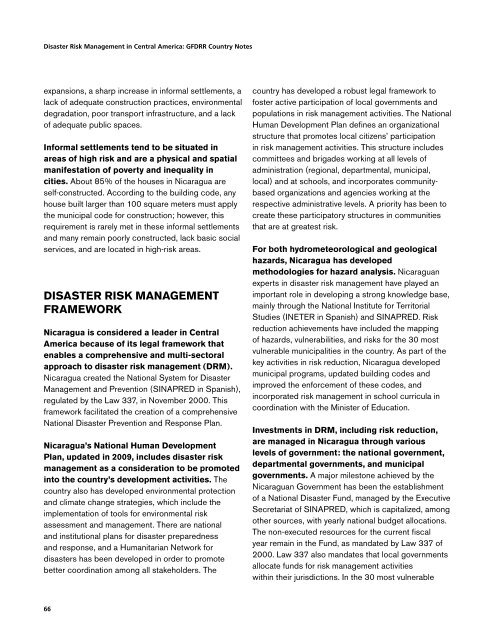Disaster Risk Management in Central America: GFDRR Country Notes
Disaster Risk Management in Central America: GFDRR Country Notes
Disaster Risk Management in Central America: GFDRR Country Notes
You also want an ePaper? Increase the reach of your titles
YUMPU automatically turns print PDFs into web optimized ePapers that Google loves.
<strong>Disaster</strong> <strong>Risk</strong> <strong>Management</strong> <strong>in</strong> <strong>Central</strong> <strong>America</strong>: <strong>GFDRR</strong> <strong>Country</strong> <strong>Notes</strong><br />
expansions, a sharp <strong>in</strong>crease <strong>in</strong> <strong>in</strong>formal settlements, a<br />
lack of adequate construction practices, environmental<br />
degradation, poor transport <strong>in</strong>frastructure, and a lack<br />
of adequate public spaces.<br />
Informal settlements tend to be situated <strong>in</strong><br />
areas of high risk and are a physical and spatial<br />
manifestation of poverty and <strong>in</strong>equality <strong>in</strong><br />
cities. About 85% of the houses <strong>in</strong> Nicaragua are<br />
self-constructed. Accord<strong>in</strong>g to the build<strong>in</strong>g code, any<br />
house built larger than 100 square meters must apply<br />
the municipal code for construction; however, this<br />
requirement is rarely met <strong>in</strong> these <strong>in</strong>formal settlements<br />
and many rema<strong>in</strong> poorly constructed, lack basic social<br />
services, and are located <strong>in</strong> high-risk areas.<br />
disaster risk management<br />
framework<br />
Nicaragua is considered a leader <strong>in</strong> <strong>Central</strong><br />
<strong>America</strong> because of its legal framework that<br />
enables a comprehensive and multi-sectoral<br />
approach to disaster risk management (DRM).<br />
Nicaragua created the National System for <strong>Disaster</strong><br />
<strong>Management</strong> and Prevention (SINAPRED <strong>in</strong> Spanish),<br />
regulated by the Law 337, <strong>in</strong> November 2000. This<br />
framework facilitated the creation of a comprehensive<br />
National <strong>Disaster</strong> Prevention and Response Plan.<br />
Nicaragua’s National Human Development<br />
Plan, updated <strong>in</strong> 2009, <strong>in</strong>cludes disaster risk<br />
management as a consideration to be promoted<br />
<strong>in</strong>to the country’s development activities. The<br />
country also has developed environmental protection<br />
and climate change strategies, which <strong>in</strong>clude the<br />
implementation of tools for environmental risk<br />
assessment and management. There are national<br />
and <strong>in</strong>stitutional plans for disaster preparedness<br />
and response, and a Humanitarian Network for<br />
disasters has been developed <strong>in</strong> order to promote<br />
better coord<strong>in</strong>ation among all stakeholders. The<br />
country has developed a robust legal framework to<br />
foster active participation of local governments and<br />
populations <strong>in</strong> risk management activities. The National<br />
Human Development Plan def<strong>in</strong>es an organizational<br />
structure that promotes local citizens’ participation<br />
<strong>in</strong> risk management activities. This structure <strong>in</strong>cludes<br />
committees and brigades work<strong>in</strong>g at all levels of<br />
adm<strong>in</strong>istration (regional, departmental, municipal,<br />
local) and at schools, and <strong>in</strong>corporates communitybased<br />
organizations and agencies work<strong>in</strong>g at the<br />
respective adm<strong>in</strong>istrative levels. A priority has been to<br />
create these participatory structures <strong>in</strong> communities<br />
that are at greatest risk.<br />
For both hydrometeorological and geological<br />
hazards, Nicaragua has developed<br />
methodologies for hazard analysis. Nicaraguan<br />
experts <strong>in</strong> disaster risk management have played an<br />
important role <strong>in</strong> develop<strong>in</strong>g a strong knowledge base,<br />
ma<strong>in</strong>ly through the National Institute for Territorial<br />
Studies (INETER <strong>in</strong> Spanish) and SINAPRED. <strong>Risk</strong><br />
reduction achievements have <strong>in</strong>cluded the mapp<strong>in</strong>g<br />
of hazards, vulnerabilities, and risks for the 30 most<br />
vulnerable municipalities <strong>in</strong> the country. As part of the<br />
key activities <strong>in</strong> risk reduction, Nicaragua developed<br />
municipal programs, updated build<strong>in</strong>g codes and<br />
improved the enforcement of these codes, and<br />
<strong>in</strong>corporated risk management <strong>in</strong> school curricula <strong>in</strong><br />
coord<strong>in</strong>ation with the M<strong>in</strong>ister of Education.<br />
Investments <strong>in</strong> DRM, <strong>in</strong>clud<strong>in</strong>g risk reduction,<br />
are managed <strong>in</strong> Nicaragua through various<br />
levels of government: the national government,<br />
departmental governments, and municipal<br />
governments. A major milestone achieved by the<br />
Nicaraguan Government has been the establishment<br />
of a National <strong>Disaster</strong> Fund, managed by the Executive<br />
Secretariat of SINAPRED, which is capitalized, among<br />
other sources, with yearly national budget allocations.<br />
The non-executed resources for the current fiscal<br />
year rema<strong>in</strong> <strong>in</strong> the Fund, as mandated by Law 337 of<br />
2000. Law 337 also mandates that local governments<br />
allocate funds for risk management activities<br />
with<strong>in</strong> their jurisdictions. In the 30 most vulnerable<br />
66
















